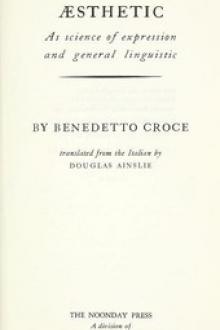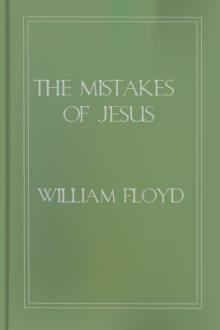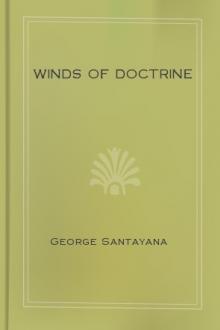The Sense of Beauty, George Santayana [e ink epub reader .txt] 📗

- Author: George Santayana
- Performer: -
Book online «The Sense of Beauty, George Santayana [e ink epub reader .txt] 📗». Author George Santayana
Such aesthetic love of uniformity, however, is usually disguised under some moral label: we call it the lore of justice, perhaps because we have not considered that the value of justice also, in so far as it is not derivative and utilitarian, must be intrinsic, or, what is practically the same thing, aesthetic. But occasionally the beauties of democracy are presented to us undisguised. The writings of Walt Whitman are a notable example. Never, perhaps, has the charm of uniformity in multiplicity been felt so completely and so exclusively. Everywhere it greets us with a passionate preference; not flowers but leaves of grass, not music but drum-taps, not composition but aggregation, not the hero but the average man, not the crisis but the vulgarest moment; and by this resolute marshalling of nullities, by this effort to show us everything as a momentary pulsation of a liquid and structureless whole, he profoundly stirs the imagination. We may wish to dislike this power, but, I think, we must inwardly admire it. For whatever practical dangers we may see in this terrible levelling, our aesthetic faculty can condemn no actual effect; its privilege is to be pleased by opposites, and to be capable of finding chaos sublime without ceasing to make nature beautiful.
Values of types and values of examples.
§ 28. It is time we should return to the consideration of abstract forms. Nearest in nature to the example of uniformity in multiplicity, we found those objects, like a reversible pattern, that having some variety of parts invite us to survey them in different orders, and so bring into play in a marked manner the faculty of apperception.
There is in the senses, as we have seen, a certain form of stimulation, a certain measure and rhythm of waves with which the aesthetic value of the sensation is connected. So when, in the perception of the object, a notable contribution is made by memory and mental habit, the value of the perception will be due, not only to the pleasantness of the external stimulus, but also to the pleasantness of the apperceptive reaction; and the latter source of value will be more important in proportion as the object perceived is more dependent, for the form and meaning it presents, upon our past experience and imaginative trend, and less on the structure of the external object.
Our apperception of form varies not only with our constitution, age, and health, as does the appreciation of sensuous values, but also with our education and genius. The more indeterminate the object, the greater share must subjective forces have in determining our perception; for, of course, every perception is in itself perfectly specific, and can be called indefinite only in reference to an abstract ideal which it is expected to approach. Every cloud has just the outline it has, although we may call it vague, because we cannot classify its form under any geometrical or animal species; it would be first definitely a whale, and then would become indefinite until we saw our way to calling it a camel. But while in the intermediate stage, the cloud would be a form in the perception of which there would be little apperceptive activity little reaction from the store of our experience, little sense of form; its value would be in its colour and transparency, and in the suggestion of lightness and of complex but gentle movement.
But the moment we said "Yes, very like a whale," a new kind of value would appear; the cloud could now be beautiful or ugly, not as a cloud merely, but as a whale. We do not speak now of the associations of the idea, as with the sea, or fishermen's yarns; that is an extrinsic matter of expression. We speak simply of the intrinsic value of the form of the whale, of its lines, its movement, its proportion. This is a more or less individual set of images which are revived in the act of recognition; this revival constitutes the recognition, and the beauty of the form is the pleasure of that revival. A certain musical phrase, as it were, is played in the brain; the awakening of that echo is the act of apperception and the harmony of the present stimulation with the form of that phrase; the power of this particular object to develope and intensify that generic phrase in the direction of pleasure, is the test of the formal beauty of this example. For these cerebral phrases have a certain rhythm; this rhythm can, by the influence of the stimulus that now reawakens it, be marred or enriched, be made more or less marked and delicate; and as this conflict or reinforcement comes, the object is ugly or beautiful in form.
Such an aesthetic value is thus dependent on two things. The first is the acquired character of the apperceptive form evoked; it may be a cadenza or a trill, a major or a minor chord, a rose or a violet, a goddess or a dairy-maid; and as one or another of these is recognized, an aesthetic dignity and tone is given to the object. But it will be noticed that in such mere recognition very little pleasure is found, or, what is the same thing, different aesthetic types in the abstract have little difference in intrinsic beauty. The great difference lies in their affinities. What will decide us to like or not to like the type of our apperception will be not so much what this type is, as its fitness to the context of our mind. It is like a word in a poem, more effective by its fitness than by its intrinsic beauty, although that is requisite too. We can be shocked at an incongruity of natures more than we can be pleased by the intrinsic beauty of each nature apart, so long, that is, as they remain abstract natures, objects recognized without being studied. The aesthetic dignity of the form, then, tells us the kind of beauty we are to expect, affects us by its welcome or unwelcome promise, but hardly gives us a positive pleasure in the beauty itself.
Now this is the first thing in the value of a form, the value of the type as such; the second and more important element is the relation of the particular impression to the form under which it is apperceived. This determines the value of the object as an example of its class. After our mind is pitched to the key and rhythm of a certain idea, say of a queen, it remains for the impression to fulfil, aggrandize, or enrich this form by a sympathetic embodiment of it. Then we have a queen that is truly royal. But if instead there is disappointment, if this particular queen is an ugly one, although perhaps she might have pleased as a witch, this is because the apperceptive form and the impression give a cerebral discord. The object is unideal, that is, the novel, external element is inharmonious with the revived and internal element by suggesting which the object has been apperceived.
Origin of types.
§ 29. A most important thing, therefore, in the perception of form is the formation of types in our mind, with reference to which examples are to be judged. I say the formation of them, for we can hardly consider the theory that they are eternal as a possible one in psychology. The Platonic doctrine on that point is a striking illustration of an equivocation we mentioned in the beginning;[7] namely, that the import of an experience is regarded as a manifestation of its cause — the product of a faculty substituted for the description of its function. Eternal types are the instrument of aesthetic life, not its foundation. Take the aesthetic attitude, and you have for the moment an eternal idea; an idea, I mean, that you treat as an absolute standard, just as when you take the perceptive attitude you have an external object which you treat as an absolute existence. But the aesthetic, like the perceptive faculty, can be made an object of study in turn, and its theory can be sought; and then the eternal idea, like the external object, is seen to be a product of human nature, a symbol of experience, and an instrument of thought.
The question whether there are not, in external nature or in the mind of God, objects and eternal types, is indeed not settled, it is not even touched by this inquiry; but it is indirectly shown to be futile, because such transcendent realities, if they exist, can have nothing to do with our ideas of them. The Platonic idea of a tree may exist; how should I deny it? How should I deny that I might some day find myself outside the sky gazing at it, and feeling that I, with my mental vision, am beholding the plenitude of arboreal beauty, perceived in this world only as a vague essence haunting the multiplicity of finite trees? But what can that have to do with my actual sense of what a tree should be? Shall we take the Platonic myth literally, and say the idea is a memory of the tree I have already seen in heaven? How else establish any relation between that eternal object and the type in my mind? But why, in that case, this infinite variability of ideal trees? Was the Tree Beautiful an oak, or a cedar, an English or an American elm? My actual types are finite and mutually exclusive; that heavenly type must be one and infinite. The problem is hopeless.
Very simple, on the other hand, is the explanation of the existence of that type as a residuum of experience. Our idea of an individual thing is a compound and residuum of our several experiences of it; and in the same manner our idea of a class is a compound and residuum of our ideas of the particulars that compose it. Particular impressions have, by virtue of their intrinsic similarity or of the identity of their relations, a tendency to be merged and identified, so that many individual perceptions leave but a single blurred memory that stands for them all, because it combines their several associations. Similarly, when various objects have many common characteristics, the mind is incapable of keeping them apart. It cannot hold clearly so great a multitude of distinctions and relations as would be involved in naming and conceiving separately each grain of sand, or drop of water, each fly or horse or man that we have ever seen. The mass of our experience has therefore to be classified, if it is to be available at all. Instead of a distinct image to represent each of our original impressions, we have a general resultant — a composite photograph — of those impressions.
This resultant image is the idea of the class. It often





Comments (0)